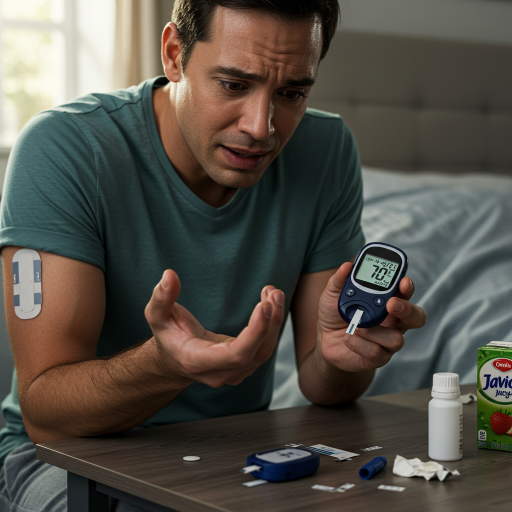
When you’re jolted awake at 3 a.m., drenched in a cold sweat, your heart thumping like a trapped bird. Your hands shake as you fumble for your glucose meter—70 mg/dL. Relief floods in… but wait. What if that number is a false low blood sugar reading? For anyone managing diabetes, this isn’t just a hypothetical—it’s a nightmare. I’ve been there, gripping my meter like a lifeline, only to realize later I’d guzzled orange juice for no reason. Let’s unravel why this happens and how to fight back.
The Silent Betrayal of False Lows
False lows are the ultimate mind game. They whisper, “Eat now,” when your body doesn’t need it—or worse, scream “You’re fine!” when you’re crashing. A study from Mayo Clinic highlights how medication side effects dominate hypoglycemia cases, but technical errors? They’re the unspoken villain.
Why Every Digit Counts
Imagine trusting a compass that spins randomly. That’s your glucose meter on a bad day. Research shows 15% of home readings are inaccurate, turning self-care into a gamble. One wrong number could send you into a sugar spiral or leave you stranded mid-hypoglycemia.
5 Sneaky Culprits Behind False Readings (And How to Outsmart Them)
Let’s get real—your meter’s not perfect. Here’s why:
1. Test Strips: The Tiny Traitors in Your Drawer
These little guys are drama queens. Leave them in a hot car? They’ll sulk and underperform. Expired? They’ll lowball your glucose by up to 20%. I once used a strip from a vial I’d left open overnight—big mistake . The reading said 65 mg/dL, but my lab test? 92 mg/dL.
Fix: Treat strips like gourmet chocolate—cool, dry, and never past their prime.
2. CGMs and the “Compression Effect”
CGMs are lifesavers, but they’re not immune to flukes. Ever slept on your sensor and woken up to a baffling low? That’s compression artifact. Your body’s pressure on the sensor muddles the interstitial fluid reading.
Fix: Rotate sites like a DJ spins tracks—weekly, and away from pressure points.
3. Triglycerides: The Invisible Sugar Thief
High triglycerides (over 500 mg/dL) can hijack your sample, pushing glucose to the sidelines. It’s like trying to hear a whisper in a rock concert.
Fix: If your labs show sky-high lipids, cross-check with venous blood tests.
4. Dirty Hands: The Sugar Smudge You Can’t See
A speck of cookie residue or sanitizer residue can skew results. I learned this the hard way after handling a sticky lollipop wrapper—my meter read 58 mg/dL, but my lab said 88 mg/dL.
Fix: Soap and water > hand sanitizer. Always.
5. Meter Mayhem: When Tech Throws a Tantrum
Static electricity, dead batteries, or wonky software can turn your meter into a liar. My old meter once spat out “ERROR” mid-hypoglycemia—thanks for nothing .
Fix: Calibrate monthly with control solution. And yes, upgrade your tech every few years.
The Gold Standard: How Labs Get It Right
Ever wonder why doctors insist on lab tests? Venous blood samples are the truth-tellers. Unlike capillary blood (fingersticks), they spin out plasma, eliminating red blood cell interference. Labs also run rigorous checks:
- Control Solutions: Daily accuracy checks.
- Proficiency Tests: Comparing results to “gold standard” samples.
- Climate Control: Strips and meters stored at 36–86°F.
Your Survival Kit: 3 Moves to Trust Your Numbers
- Perfect Your Prick
- Target the fleshy side of your fingertip—less pain, better flow.
- Let the drop fall naturally. Squeezing? You’re diluting the sample.
- Audit Your Arsenal
- Ditch generic strips. Stick to FDA-cleared brands (yes, even if they cost more).
- Replace meters every 2–3 years—technology evolves faster than you think.
- Double-Check Like a Detective
- Compare fingersticks to lab results quarterly.
- If symptoms clash with readings, demand a venous test.
FAQ: Your Burning Questions, Answered
Q: Can stress hormones mess with readings?
A: Absolutely. Adrenaline spikes from panic can mask lows or mimic highs. Breathe first, test second.
Q: Do I really need to calibrate? It’s such a hassle.
A: Think of it like tuning a guitar. Skip it, and you’ll sound off-key.
False lows aren’t just numbers—they’re wolves in sheep’s clothing. But armed with lab-grade habits and a dash of skepticism, you can outsmart them. Share this with your diabetes crew, then march to your doc and demand a meter check. Because when it comes to blood sugar, close enough isn’t good enough
